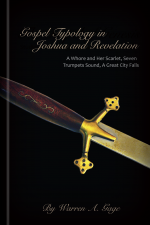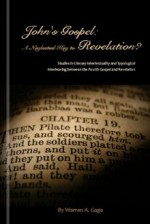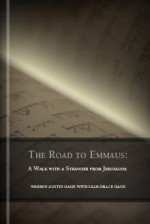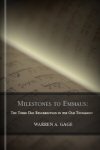
By Warren A. Gage
The Church Fathers interpreted Joshua’s battle at Jericho as foretelling the end of the world. Did they understand something about prophecy we’ve forgotten?
A whore and her scarlet, two spies (witnesses) sent into the great city, seven trumpets sound, a great city falls, the people of God rescued. Is Joshua’s battle against Jericho the basis for nothing less than the dramatic narrative of the Book of Revelation?
This new work from author and teacher Warren A. Gage illuminates the connections between the books of Joshua and Revelation and emphasizes the presence of Joshua typology in the life of Jesus. Gage also discusses the typology of holy war in general and the battle at Jericho specifically, the typological prominence of Rahab in the New Testament, and specific connections between the texts of Joshua and Revelation.
The early Church Fathers understood the profound significance of the “Joshua” name of Jesus and viewed Joshua’s battle at Jericho as a prefiguration of Jesus’ battle against Jerusalem. However, modern Revelation scholarship has focused upon connections to Daniel, Ezekiel, and especially Isaiah. Gage brings the discussion back to the historical books, back to Joshua and the fundamental retelling of his narrative in Revelation.
This collection is part of the Literary Biblical Theology Collection (11 vols.)
Key Features
- Examines the intertextual relationship between the books of Joshua and Revelation
- Explains the Gospel themes in Joshua and why the Savior was named for Joshua
- Analyzes the typology of Holy war and explains the prominence of Rahab in the New Testament
Contents
- Joshua Typology in the New Testament
- The Typological Prominence of Rahab in the New Testament
- The Bloody Sword of Joshua: The Typology of Holy War
- The Kerygmatic Imagination of St. John: Joshua Typology in the Book of Revelation
- The Iconic Imagination of St. John and St. Matthew: Joshua Prefiguring the Lord Jesus
- Christ Greater than Joshua: Meditations on the Book of Joshua
Product Details
- Title: Gospel Typology in Joshua and Revelation: A Whore and Her Scarlet, Seven Trumpets Sound, A Great City Falls
- Author: Warren A. Gage
- Publisher: St. Andrews House
- Publication Date: 2013
- Pages: 90
Buy

By Warren A. Gage
Overview
John’s Gospel begins with a war between light and darkness (John 1:5), but this war is not consummated until darkness is vanquished at the end of John’s Revelation (Rev. 21:25). John’s Gospel begins with the claim that the divine Word is tabernacled among us in Jesus (John 1:14) while John’s Revelation ends by claiming that the tabernacle of God will be among men forever (Rev. 21:3). Jesus comes down from heaven as a bridegroom in the Gospel (John 1:14; 3:29), but there is no bride coming down from heaven until the end of Revelation (Rev. 21:2).
John’s Gospel: A Neglected Key to Revelation? explores the literary and thematic patterns—both consecutive and chiastic—that tie the fourth Gospel and Revelation together. When read as a literary diptych, the two books create a pattern of interlocking typologies. Warren Gage suggests that they were composed to interpret each other. An appendix further supports that thesis by demonstrating that the same consecutive, literary and thematic patterns are discernible in the Gospel of Luke and Acts—books generally recognized as penned by the same hand.
This collection is part of the Literary Biblical Theology Collection (11 vols.)
Key Features
- Explores the literary and thematic patterns linking the Gospel of John and Revelation
- Analyzes the interpretive relationship between the two books
- Includes an appendix to further support Gage’s thesis
Contents
- The Vision of the Seven Last Angels
- The Music of St. John: A Symphonic Reading of the Fourth Gospel and Revelation
- The Kerygmatic Imagination of St. John
- The Iconic Imagination of St. John
Product Details
- Title: John’s Gospel: A Neglected Key to Revelation?
- Author: Warren A. Gage
- Publisher: St. Andrews House
- Publication Date: 2001
- Pages: 235
Buy

By Warren Gage
The Gospel of Genesis: Studies in Protology and Eschatology focuses on that there is an underlying eschatology in Genesis that foresees the sweep of redemptive history and the end of all things as, after the pattern of the beginning, a new creation. Gage examines the structure of, and literary parallels in, the historical records, identifying five major theological themes with a Genesis 1–7 basis. He traces these themes through Scripture, showing that the Bible’s eschatology is intimately bound up with the protology of the early chapters of Genesis. This second edition includes a new introduction.
This collection is part of the Literary Biblical Theology Collection (11 vols.)
Key Features
- Examines the relationship between eschatology and protology
- Analyzes five theological themes with a Genesis 1–7 basis
Contents
- Part One: The Gospel of Genesis
- Chapter One: Introduction
- Chapter Two: The Eschatological Structure of Genesis
- Chapter Three: The Creator God as Cosmic Redeemer
- Chapter Four: The First Adam and the Last Adam
- Chapter Five: Judgment, Salvation, and the Oracle of Destiny
- Chapter Six: The City of God and the Cities of Men
- Chapter Seven: The Flood of Noah and Prophetic Judgment
- Part Two: A Meditation on Genesis 1–12
- The History of the World That Was: Genesis 1–7
- The Historical Beginnings of the World That Is: Genesis 8–12
Product Details
- Title: The Gospel of Genesis: Studies in Protology and Eschatology
- Author: Warren A. Gage
- Edition: 2nd
- Publisher: St. Andrews House
- Publication Date: 2010
- Pages: 113
Buy

By Warren A. Gage
How did Jesus spend the afternoon of the day of his resurrection? This fictional account attempts to recreate the conversation Jesus had with Cleopas and his companion on the walk to Emmaus. The dialogue follows the pattern of “THIRD DAY” passages in the Old Testament that describe a release from death. It begins, as Jesus did, with “Moses and all the prophets.” Join us on this walk. See if your heart does not “burn within” you as Christ’s suffering and third day glory are opened in the Old Testament, just as Jesus claimed!
Key Features
- Analyzes resurrection references and figures of speech in the Old Testament
- Provides fresh insight on resurrection theology
Contents
- The Evening of the First Day
- The Morning of the Second Day
- The Evening of the Second Day
- The Morning of the Third Day
- The Noon Hour of the Third Day
- The Mid-Afternoon of the Third Day
- The Evening of the Third Day
- The Return to Jerusalem
- Jerusalem Comes into View Again
Product Details
- Title: The Road to Emmaus: A Walk with a Stranger from Jerusalem
- Authors: Warren A. Gage and Leah Grace Gage
- Publisher: St. Andrews House
- Publication Date: 2012
- Pages: 118
Buy
By Warren A. Gage
Does the Old Testament clearly teach the resurrection? Every time Jesus speaks of his coming resurrection, he claims that the Scriptures teach that it must happen on “the third day” (Matt. 16:21; Mark 8:31; Luke 9:22; John 2:19). Paul, likewise, teaches that the Scriptures require Christ’s resurrection to be on the third day (1 Cor. 15:4). Milestones to Emmaus explores 40 explicit references to “THE THIRD DAY” or “THREE DAYS” in the Old Testament. Gage applies the “suffering followed by glory” template that Jesus taught (Luke 24:26) to each reference. Approaching each of these as gospel texts in the Hebrew Bible, Gage “reverse engineers” his way back to an understanding of Jesus’ resurrection hermeneutics.
Milestones to Emmaus: The Third Day Resurrection in the Old Testament is part of The Resurrection of Jesus in the Hebrew Old Testament Collection (3 vols.) and the Literary Biblical Theology Collection (11 vols.)
Buy




